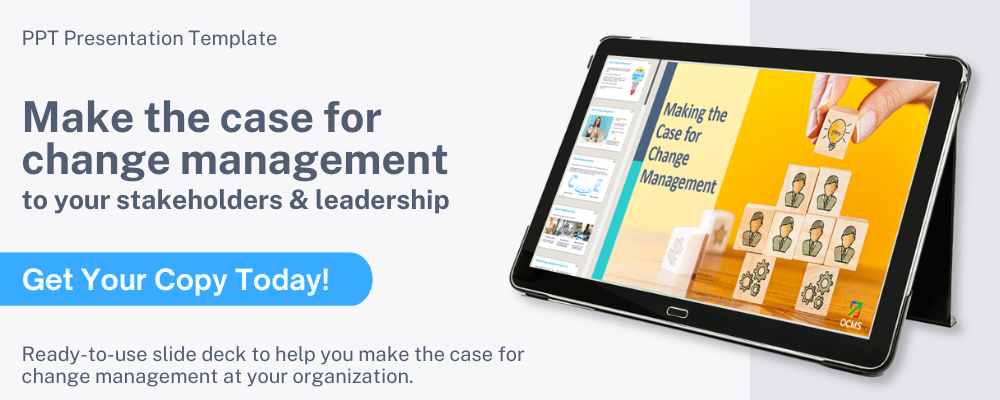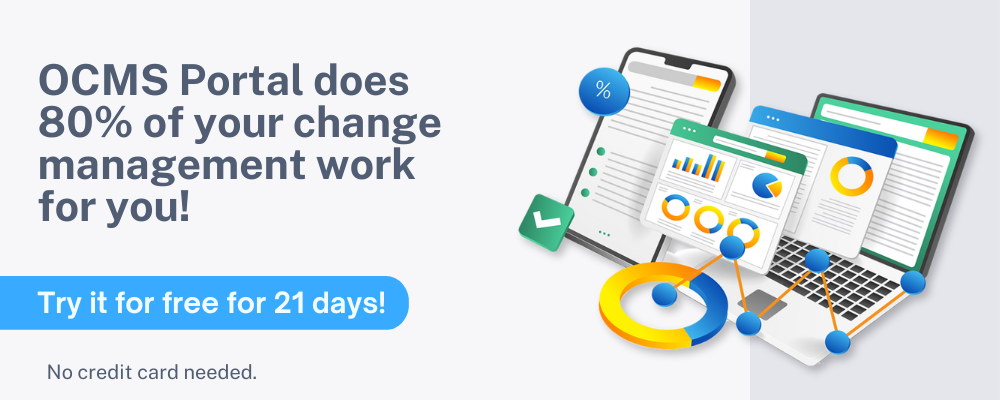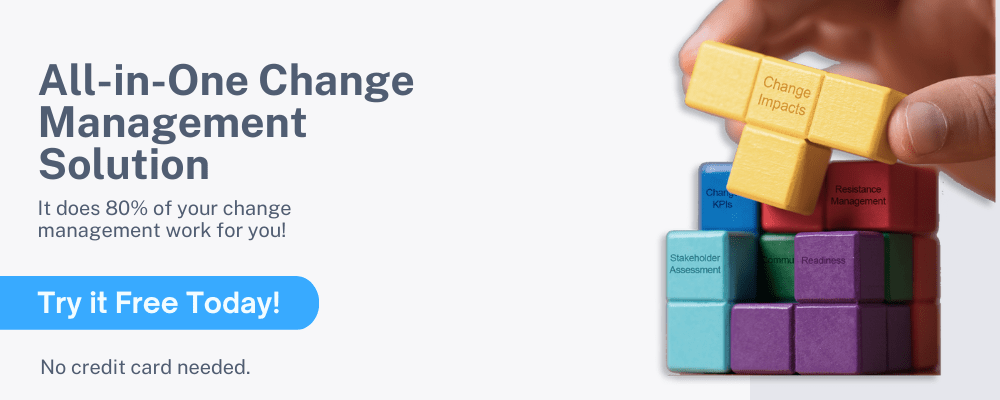What is Organizational Change Management (OCM)?
When an organization adopts a new software, changes a procedure, or goes through any type of transformational event, like a merger, it changes.
It changes the way something has been done up to that point and gives employees instructions on how things are to be done going forward.
Change is an ongoing process in any company and can come from both internal and external forces.
Internally, a company may change the way something is done to break into new markets, take advantage of technology, and expand its operations.
External forces can include economic downturns requiring offices to close, or a change in consumer buying behavior that a company needs change to adapt to.

What is Change Management Process?
What is change management? It’s the procedures and strategies used to guide that change from “the way things WERE done” to “the NEW way of doing things” successfully.
People Need to Change for Organizations to Change
A key tenant of change management is that people need to change for organizations to change successfully. A company can have a great plan on paper and tell employees what’s expected, but if employees don’t support the change or make the necessary changes in their own daily behaviors, then the change will fail.
As many as 70% of change fails to achieve the desired outcome, and most of those failures are due to employees resisting and not supporting the change.
The purpose of change management is to guide the people in an organization through the change and turn resistance into support so that the organization can achieve the desired results for a change project.
See Also: What Does a Change Program Manager Do?
What Does Change Management Mean?
When asking, “What is OCM?” or “What is organizational change management?”, people often want to know what’s involved. What does it mean to “manage” change?
Change management means that you don’t just expect employees to understand why a change needs to happen and automatically adopt the necessary processes to make it happen.
What is meant by change management is that employees have to be considered every step of the way when there is an organizational change. Their feelings, resistance, training, and timeline for adoption need to be adequately managed.
Change management starts with the stakeholder, which is any person that is impacted by a change. Stakeholders need to be managed through best practices of change management to help them understand the benefits of a change, learn the new processes, and have a willingness to change so the organization can change.
Change models representing certain methodologies will often be used as a guide for implementing change management. Each includes the importance of people being the main driver for change.
What does change management mean? Really, it means people management.
What is the Purpose of Change Management?
The purpose of change management is to ensure an organizational change happens successfully.
Success can be defined by the ROI of the project, the ability to accomplish objectives that the change was designed to enable, and other goals that were the expectation after the change was made.
Change management professionals study methods of change management and from asking, “What is change management process?”, they choose a set of best practices to follow to drive the change forward from the individual level up.
According to a study on organizational change management by McKinsey, when change management was used for an organizational change, the average ROI was 143% (so they gain 43 cents on each dollar spent).
But when change management wasn’t used during a change, the average ROI was just 35%, meaning the project lost 65 cents for each dollar spent.
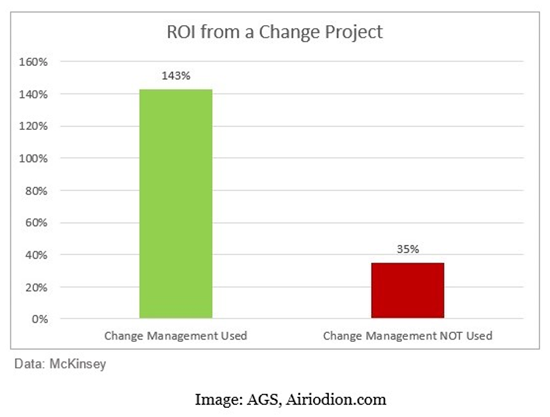
When answering, “What is change management and its purpose?” the simple answer is: The purpose of change management is to ensure a change succeeds and meets or exceeds expectations.
Don’t Miss: ITIL Certification, Exam Cost, Test Questions | All You Need to Know
What is Change Management Process or Phases?
While an entire change management plan has multiple steps, the change itself is typically reflected in three phases.
These three phases answer, “What is change management process?” in a bird’s eye overview. Several of the popular change models use this 3-phase description, and although they may name each phase differently, each represents the same journey.
The journey is from the current state through the transition to the future state.
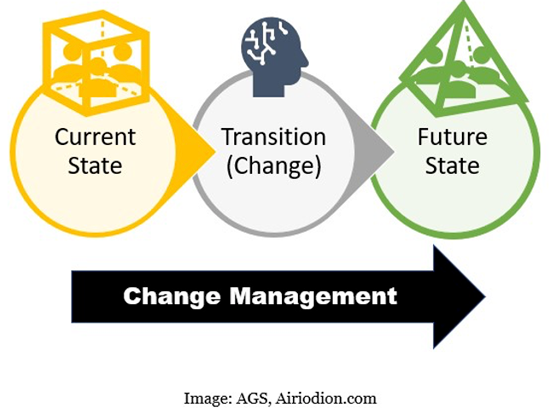
What is Change Management Process in Detail?
Each of the phases in the change management process represents a state that a stakeholder – i.e., the individual impacted by the change – has to pass through during the change.
- Current State: This is the way things are being done now. It represents the habits that have been ingrained in order for employees to perform their daily tasks. The first phase is leaving the current state behind and preparing to make changes.
- Transition: The transition is the main area where, “What is OCM?” takes place. This is where employees are learning the new processes, being reassured about the change, and where change managers are putting the new systems in place to support the change.
- Future State: This is the new way of doing things and what was envisioned when the change project was first initiated. What is meant by change management in this stage is that stakeholders will still need support to ensure they “stick” to the new processes and don’t revert to the old way of doing things.
Change Models & How They Describe the 3 Phases of Change Management
What does change management mean to different popular change models?
We’ve taken a look at three different change models that each describe three phases of change management. These include the Lewin Model, Bridges Model, and ADKAR Model.
Each model describes a specific change methodology relating to how to implement change management successfully and answer the question, “What does change management mean?”
| Phases of Organizational Change | |||
| Change Models | Phase 1 | Phase 2 | Phase 3 |
| Lewin Model | Unfreeze | Change | Freeze |
| Bridges Model | Endings | Neutral Zone | New beginnings |
| ADKAR Model | Preparing for change | Managing change | Reinforcing change |
How Change Models Answer, “What is Change Management Process?”
- Lewin Model: The Kurt Lewin model for change management describes the need to unfreeze an individual’s habits and behaviors, then guide them through the change. Once they’ve learned the new process, those new habits and behaviors need to freeze, meaning be reinforced, so they become the new normal.
- Bridges Model: The change management model by William Bridges looks at the stages from a personal perspective. It recognizes that for an individual, leaving the current state of doing things means an ending. As they go through the change, described as a neutral zone, a person can have both positive and negative feelings. Finally, once the new process is in place, phase three is described hopefully as new beginnings.
- ADKAR Model: The Prosci ADKAR® Model also includes the three phases 0f change management, beginning with preparing for change. As the team guides stakeholders through the project, they are managing change. Once the project is complete, it’s then important to be reinforcing change, so it is sustained over the long term.
What is OCM? | Two Levels of Change
When answering, “What is organizational change management?”, it’s important to understand that change happens on two different levels. These are the organizational level and the individual level.
Where many change projects go wrong is that they only consider the organizational level.
Executives may see the need to change from one software to another to save money and improve efficiency. But they may not fully appreciate what changing from the old software to the new software will mean to the employees that use it every day.
If an organization is only concentrating on the organizational level of change and not the individual level, then there’s a good chance that the project will meet resistance. People won’t consistently adopt the new process, and therefore both individual and organizational levels of change will fail, with one bringing down the other.
What does change management mean?
It means that the individual level of change is given priority and managed successfully so that change happens at both levels.
Individual Change
Individuals are naturally resistant to change. We get comfortable, form habits, and our workday gets a rhythm to it because some tasks become automatic. Your brain doesn’t need to work as hard because you have a routine.
Any change in that routine will bring about feelings of anxiety, fear, and apprehension. Employees may be worried that the new processes will be harder to do or upset that things are being changed at all.
Managing this natural and psychological resistance to change is a big part of the answer to, “What does change management mean at the individual level?”
The purpose of change management for individuals is to get them past those initial feelings of resistance to a place where they are supportive of the change and have a desire to adopt the new processes.
Organizational Change
When a needed change is first identified, it’s naturally related to the organization’s need to change. A company may find that they need to expand into a new market to meet revenue needs or want to transition from analog to a cloud phone system to reduce overhead.
When asking, “What is OCM and its purpose?”, an organization will typically do a project assessment to identify the organizational level change that needs to happen and desired results.
While the organizational level of change is typically the end game and purpose of change management, this level of change can’t happen successfully unless the individual level of change happens with the employees throughout the organization.
Related: Top Project Management Companies & Consulting Firms
What is Meant by Change Management Resistance?
Managing the natural resistance to change that individuals have is a big part of organizational change management.
It involves identifying resistance, which comes in many forms, and finding ways to overcome that resistance through communication, strategic use of leadership and a change champions network.
Why Do People Resist Change?
Individuals resist change for many reasons. It can be related to their personality type, for example, someone that naturally craves habit and dislikes change. Or it can be related to them having been through a bad change experience in the past.
What is organizational change management resistance to a project? Resistance can show up in many forms, but any of them can derail a change project.
Here are some of the typical reasons that people resist change in an organization:
- They are afraid they can’t adapt to the new process
- Because things are “fine as they are” and they don’t know why things are changing
- They are already stressed and overwhelmed and can’t take on one more new thing
- They see this as the “change of the week” and expect that it won’t stick around
- They created the current process and are invested in it personally
- They are confused and haven’t been told how they’ll be trained
- Their supervisor or peers are resisting, so they do as well
What is Meant by Change Management Resistance Mitigation?
Resistance mitigation, which is also known as resistance management, is a process by which resistance to a change is identified and resolved.
It involves both proactive and reactive resistance management.

What is Change Management Process? | Resistance Management
Proactive Resistance Management:
Proactive resistance management involves doing a stakeholder analysis to identify who might potentially be resistant to a change. Have they had past bad experiences with change? Is their work life going to be impacted more than others?
By identifying who may potentially be resistant and communicating with them to alleviate potential fears about the change, resistance can often be mitigated before it has a chance to start.
Reactive Resistance Management:
What does change management mean when it comes to reactive resistance management?
It won’t be possible to anticipate everyone’s potential resistance to organizational change, so it’s important to be on the lookout for resistance and then react to it as soon as it happens.
Reactive resistance management involves using supervisors and a change champions network to help watch for users that are exhibiting signs of resistance, such as not showing up for change meetings and training or vocally expressing displeasure about the change.
What Are the 4 Change Management Roles?
The purpose of change management includes leveraging resources to mitigate resistance and drive a change project forward.
There are typically four main change management roles when it comes to the people driving a change for an organization. These include:
- Change Managers
- Leadership
- Change Champions
- Impacted Employees (Stakeholders)
Each has a specific part to play in answering, “What is OCM for our organization?” If each role doesn’t work in unison, then miscommunication can happen, and a change project can easily be derailed.
Change Managers
Change managers are the ones leading the organizational change project. They will be responsible for creating the change plan, implementing the assessments of the organization and stakeholders, mitigating resistance, and basically driving all three phases of the change project forward successfully.
Leadership
Leadership has a vital role to play in an organizational change. Because leaders often set the tone for an organization and individuals look to them for guidance, it’s important they support the change and help drive it in their individual departments.
Change managers will conduct leadership coaching to teach leaders how to do things like identify and resolve resistance to change and act as a liaison between employees and the change managers.
Change Champions
Another area of change management best practices includes identifying key employees throughout the organization that can act as support for the change, and help promote change communications with their peers.
Setting up a change champions network is one of the tasks that change managers do during the initial phase of a change project. This network is vital to helping explain, “What does this change and what does change management mean?” to their fellow colleagues.
Impacted Employees/Stakeholders
This role is key to organizational change happening. The employees impacted by the change need to have a desire and willingness to adopt the new processes so the change can happen successfully.
The answer to “What is change management process focus?” The answer is that the main focus of the change management process are the impacted employees and guiding them through the change.
Popular Article: Change Management Career Path & Salary
What is a Typical Change Management Plan?
A change project will have a project plan, which lays out the steps to take in each phase of the change project. This acts as a road map, just like any other project plan, to keep everything on track and create a timeline of actions.
Here is how a typical change management plan is laid out according to the three phases.
Phase 1: Current State/Preparing for Change
- Project assessment
- Creating a budget, timeline, and change management plan
- Organizational readiness assessment
- Stakeholder analysis
- Leadership coaching
- Change champions network setup
Phase 2: Transition/Implementing the Change
- Resistance Management
- End-User Training
- Change project communications
- Asset allocation need for change (software, etc.)
- Tracking of change project metrics
Phase 3: Future State/Reinforcing the Change
- Change reinforcement & user helpdesk
- Gathering user feedback
- Recognitions and celebration
- Close change project
Costs of Not Properly Managing Change
When change is not managed well, and change management best practices aren’t used, it can lead to several consequences.
These include various levels of change project failure, such as:
- Users reverting to the old way of doing things
- Change projects not achieving positive ROI
- Good employees leaving the company due to the change
- Company operations being disrupted after the change is in place
- Customer service or another important KPI falling
- Fractures happening in organizations between change supporters and change resisters
What is OCM’s purpose? To avoid potential bad outcomes for a change project by nurturing stakeholders and carefully guiding the entire process.
Benefits of Effective Change Management
When change management is handled effectively, it can make all the difference in not only the success of the change project, but also in how employees feel about it.
For many companies, the answer to “What is organizational change management?” is a way to get employees to support a change and bring an entire organization together for the better.
Some of the benefits of properly managing a change include:
- Positive project ROI
- Project outcomes that meet or exceed expectations
- A sense of pride and accomplishment
- Employees feeling like a cohesive team
- Identification of future leaders among change champions
- Ability to change and adapt more easily in the future
How Do You Effectively Implement Change?
You can effectively implement change by understanding that people drive change and that the organizational level cannot change until the individual level of the company changes.
Using change management practices to plan and implement a change strategy can help you ensure that change-stopping resistance is overcome. It’s also a way to help ensure everyone is motivated behind a common cause so that the change happens successfully.
Read More: Change Management Interview Questions and Answers
Conclusion: Everything You Need to Know to Answer, “What is Change Management?”
There is an expression that the only constant is change, and organizations live this reality day in and day out. They may be changing to innovate and improve efficiency or changing to adapt to a world that changes around them.
Ultimately, the answer to “What is meant by change management?” is the management of the people going through the change to help them through each phase successfully.
Anytime an organization is changing, it’s the employees that are actually enacting the change, which is why change management focuses on the “people” part of the change and is vital to ensuring a change happens.
Note: Content on OCM Solution's ocmsolution.com website is protected by copyright. Should you have any questions or comments regarding this OCM Solution page, please reach out to Ogbe Airiodion (Change Management Lead) or the OCM Solution Team today. OCM Solution was previously known as Airiodion Global Services (AGS).
Images: Microsoft 365 Clip Art Image(s) (Bing images licensed under the Creative Commons license system.), https://pixabay.com/photos/business-meeting-meeting-business-5395567/



